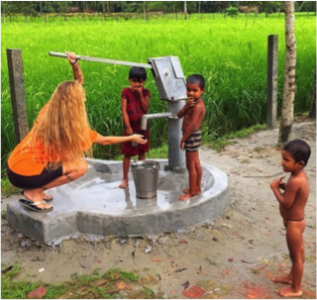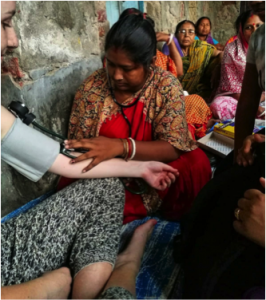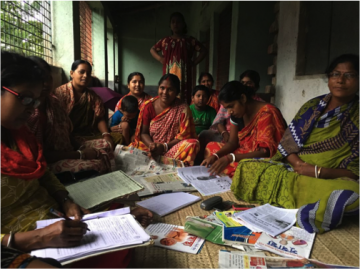Upon learning that we had six weeks of FLEX time to pursue a project of our own choosing I decided that this would be the perfect opportunity to get a taste of what “global health” entailed. Rather than doing a research project in Vancouver, I wanted an experience that would push me outside my comfort zone and expose me to a new side of medicine, so I chose to travel to Kolkata, India to work with the Institute for Indian Mother and Child (IIMC).
I originally chose the IIMC because it was one of the few organizations that did not promote “volun-tourism”, it had a medical program, and fit nicely with my schedule. I received very little information about the organization before departure and our communication was limited due to their lack of technology. Therefore, I decided I would gather information to critically appraise the IIMC while in Kolkata, booked my flight, and checked “find FLEX project” off my to do list. It was not until I walked out of my last exam and started reading about Kolkata’s burden of disease that the excitement and worry (mostly worry) started to settle in. After receiving what seemed like my billionth vaccination, packing four bottles of jungle grade bug spray, and convincing myself that I would surely not leave the country without contracting TB, I was ready to go.
 Thirty-three hours later the humidity, noise, and smell of Kolkata hit me. The IIMC driver picked me up on time… for India (around an hour late). Soon I found myself not only sticking but also clinging to my seatbelt-less seat as the IIMC driver casually swerved through traffic, one hand resting firmly on the horn. I stared out the window at the chaos, and as the car started to slow on a street in which the locals were washing their dishes, laundry and bodies under a small water pump, doubt filled my mind. I followed the driver into the guesthouse, thinking: “at least now I can get out of the 40-degree heat”. My welcome to the guesthouse consisted of me learning that there was no air conditioning.
Thirty-three hours later the humidity, noise, and smell of Kolkata hit me. The IIMC driver picked me up on time… for India (around an hour late). Soon I found myself not only sticking but also clinging to my seatbelt-less seat as the IIMC driver casually swerved through traffic, one hand resting firmly on the horn. I stared out the window at the chaos, and as the car started to slow on a street in which the locals were washing their dishes, laundry and bodies under a small water pump, doubt filled my mind. I followed the driver into the guesthouse, thinking: “at least now I can get out of the 40-degree heat”. My welcome to the guesthouse consisted of me learning that there was no air conditioning.
Despite the initial culture shock the guesthouse rapidly became home. The lack of hot water made the showers wonderfully refreshing, doing laundry in buckets while showering was super efficient, and thanks to the air pollution I did not even need sunscreen!
 My daily routine began at 5am when the neighbour’s chicken crowed. I would roll over and sleep another hour until the ice cream man’s yells competed with the conches that were blown at puja. Eventually the other international volunteers and I crawled out of our sweat-drenched beds and headed to the IIMC’s indoor clinic via metro and tuctuc, bargaining for fruit along the way. From there we were driven in an ambulance to an outdoor clinic. The outdoor clinics were situated in rural communities on the outskirts or outside of Kolkata, and each clinic was open one or two days a week. At the outdoor clinics we spent the majority of our time completing tasks such as applying antibiotic/antifungal creams, measuring blood pressures, or giving injections. However, we were also able to shadow various doctors and work in the pharmacy. Upon return to the indoor clinic we ate a late lunch and then had flexible time. Personally, I worked on a variety of projects. These included travelling to IIMC schools to perform health check-ups and teach dental hygiene, attending women peace council meetings and holding lectures for the health network women. Volunteers are also given the opportunity to implement their own projects/initiatives. My group decided to create very basic posters for the outdoor clinics that educated patients about preventing the commonly seen skin infections. In the evenings we headed home together, picking up delicious street food for less than $1.
My daily routine began at 5am when the neighbour’s chicken crowed. I would roll over and sleep another hour until the ice cream man’s yells competed with the conches that were blown at puja. Eventually the other international volunteers and I crawled out of our sweat-drenched beds and headed to the IIMC’s indoor clinic via metro and tuctuc, bargaining for fruit along the way. From there we were driven in an ambulance to an outdoor clinic. The outdoor clinics were situated in rural communities on the outskirts or outside of Kolkata, and each clinic was open one or two days a week. At the outdoor clinics we spent the majority of our time completing tasks such as applying antibiotic/antifungal creams, measuring blood pressures, or giving injections. However, we were also able to shadow various doctors and work in the pharmacy. Upon return to the indoor clinic we ate a late lunch and then had flexible time. Personally, I worked on a variety of projects. These included travelling to IIMC schools to perform health check-ups and teach dental hygiene, attending women peace council meetings and holding lectures for the health network women. Volunteers are also given the opportunity to implement their own projects/initiatives. My group decided to create very basic posters for the outdoor clinics that educated patients about preventing the commonly seen skin infections. In the evenings we headed home together, picking up delicious street food for less than $1.
 Although the work was simple, I could fill pages and pages with all of my crazy experiences. For the sake of this blog I will focus on one event in particular. During the first week a 7-year-old boy came into the clinic. He had a cut on his head, which had become infected. Although this would not have amounted to much in Vancouver, the different hygiene standards in Kolkata had allowed the small cut to swell to the size of a baseball. With the help of a doctor we drained, disinfected, and covered the wound and sent the child home with antibiotics. We repeatedly asked the boy’s mother to return to the clinic the next day, but patients are often unable to take the time to get medical help or have other priorities and do not return. Fortunately, they returned later that evening. Two other volunteers and I admitted the boy after taking another look at his head and realizing there were maggots crawling around inside. Due to limited health care supplies, we had to extract five maggots from deep inside the wound using tweezers, without any anaesthetic.
Although the work was simple, I could fill pages and pages with all of my crazy experiences. For the sake of this blog I will focus on one event in particular. During the first week a 7-year-old boy came into the clinic. He had a cut on his head, which had become infected. Although this would not have amounted to much in Vancouver, the different hygiene standards in Kolkata had allowed the small cut to swell to the size of a baseball. With the help of a doctor we drained, disinfected, and covered the wound and sent the child home with antibiotics. We repeatedly asked the boy’s mother to return to the clinic the next day, but patients are often unable to take the time to get medical help or have other priorities and do not return. Fortunately, they returned later that evening. Two other volunteers and I admitted the boy after taking another look at his head and realizing there were maggots crawling around inside. Due to limited health care supplies, we had to extract five maggots from deep inside the wound using tweezers, without any anaesthetic.
While the locals were completely unfazed I was shocked. A maggot infested wound was not something I had ever seen before. I was also blown away by the boy’s bravery. Despite having to hold him down to extract the maggots as he screamed in pain, he eagerly helped me dress his wound in the following days. Most importantly however I think that this experience opened my eyes to the importance of education and helped me understand the IIMC’s mission. Had the boy’s family known how to clean a wound they could have prevented the infection, and if they had known how to identify an infected wound, they could have taken him to the clinic sooner. This is why, although volunteers spend most of their time providing medical care, the IIMC actually focuses primarily on education and women empowerment. The medical clinics are a way to provide immediate, but short-term aid to both gain the communities trust and engage them. However it is the schools, women peace councils, and micro-credit programs that truly aid the rural areas around Kolkata. I believe that working with the IIMC and seeing this first hand is an incredibly valuable and humbling experience for any medical student.
 Lastly, I would like to emphasize that the IIMC is a vast organization with a few main projects (education, women empowerment, micro-credit, and health-care) but also many smaller ones such as the child sponsorship program. Here people from all over the world donate 20 euros monthly to give a child access to education and health care. Therefore, anyone anywhere can become involved. For me, working with the IIMC was an unforgettable experience and one I highly recommend.
Lastly, I would like to emphasize that the IIMC is a vast organization with a few main projects (education, women empowerment, micro-credit, and health-care) but also many smaller ones such as the child sponsorship program. Here people from all over the world donate 20 euros monthly to give a child access to education and health care. Therefore, anyone anywhere can become involved. For me, working with the IIMC was an unforgettable experience and one I highly recommend.
If you have any questions please don’t hesitate to send me an email (anna.black@alumni.ubc.ca) or you can visit the IIMC’s website: http://iimcmissioncal.org/. Thanks!
Anna Black is a second year medical student at UBC.